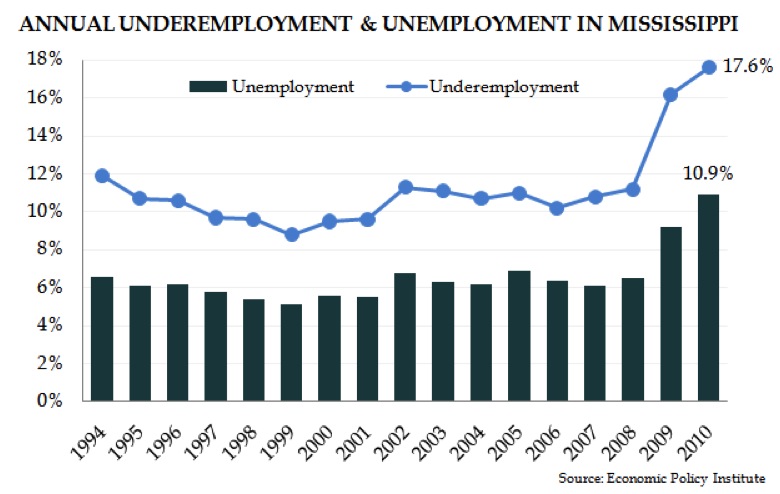A Closer Look: Underemployment in Mississippi
August 16th, 2011
In response to comments on a previous post on unemployment and jobs, MEPC wanted to take a closer look at Mississippians who are looking for full-time work but are not necessarily counted in the traditional unemployment rate. The following post walks through key parts of the underemployment rate, a broader measure of the portion of Mississippi’s workforce potentially encountering obstacles to full-time employment.
Putting Annual Underemployment in a Historic Context
Underemployment includes several key groups – the unemployed, discouraged workers who have temporarily given up looking for employment, marginally attached workers, and those that have taken a part-time job when they would prefer to be employed full-time. In 2010, Mississippi’s underemployment rate reached 17.6 percent, substantially higher than the traditional unemployment rate of 10.9 percent. Persistently high underemployment in 2009 and 2010 underscores the length and severity of this recession relative to others the state has experienced. Even in Mississippi’s last economic downturn in the early 2000s, annual underemployment registered well below the current levels. See Chart.
Click to enlarge
Discouraged Workers
A select portion of Mississippians want to work but have given up looking for employment because they perceive that opportunities are not currently available – called discouraged workers. Quarterly averages, from the end of 2010 to the middle of 2011, report the traditional unemployment rate was 10.1 percent but including discouraged workers pushed the rate upwards to 10.9 percent. The gap between total unemployed + discouraged workers signals that 0.8 percent of Mississippi’s labor force has temporarily given up looking for work in the current economic environment. The table below compares the most recent quarterly averages of four measures of labor utilization for the United Staes and Mississippi.
Click to enlarge
The persistence of underemployment across the state has impacted the economic security of many households. Some Mississippi workers have even temporarily given up looking for work. To connect more Mississippi workers with full-time employment, the nation and state will need to build investments in proven strategies for skill development of the state’s adults. Efforts, like on-the-job training, apprenticeship programs, and individual training accounts, can be incorporated into sector-based strategies that connect employers with the skilled workforce they need and help bridge entry-level workers into employment.
Author:
Sarah Welker, Policy Analyst







